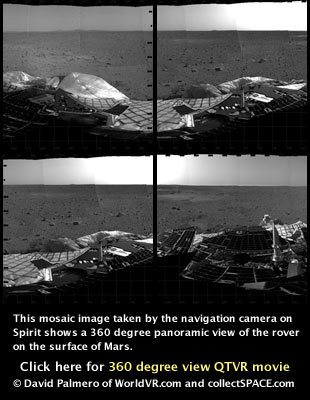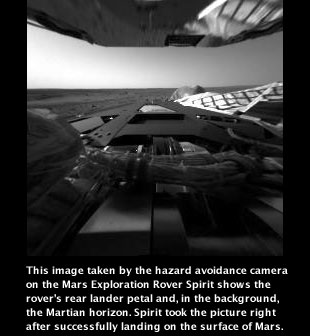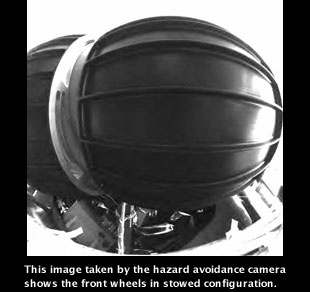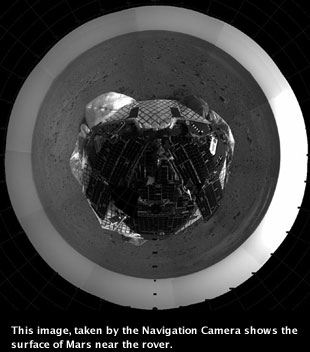|
|

|
Spirit lands and sends 360° postcards
collectSPACE First: QuickTime VR panoramas
| QuickTime VR movies © collectSPACE, WorldVR.com |
 |
| 0112 |
|
Mars View in Full Color |
|
PanCam |
|
784k |
The first 360-degree color view from NASA's Spirit Mars Exploration Rover presents a range of tempting targets from nearby rocks to hills on the horizon. The panorama is a mosaic stitched from 225 frames taken by Spirit's PanCam. It spans 75 frames across, three frames tall, with color information from shots through three different filters. |
| |
 |
| 0106 |
|
Spirit's First Color Image* |
|
PanCam |
|
1.4mb |
Images in this mosaic are the highest-resolution pictures ever sent from Mars, more than three times as detailed as images from Mars Pathfinder in 1997. One-eighth of a full-circle panorama, this scene rises from near the edge of the lander platform to the sky. |
| |
 |
| 0105 |
|
First 3-D B&W Panorama |
|
NavCam |
|
216k |
This sprawling look at the martian landscape surrounding the Mars Exploration Rover Spirit is the first 3-D stereo image from the rover's navigation camera. |
| |
 |
| 0104 |
|
First Look at Spirit on Mars |
|
NavCam |
|
390k |
| Zoom in and out using Shift and Command/Control keys. |
For more images from Mars, see NASA's website.
January 4, 2004 -- A traveling robotic geologist from NASA has landed on Mars and returned stunning images of the area around its landing site in Gusev Crater.
Mars Exploration Rover Spirit successfully sent a radio signal after the spacecraft had bounced and rolled for several minutes following its initial impact at 11:35 p.m. EST (8:35 p.m. Pacific Standard Time) on January 3.

"This is a big night for NASA," said NASA Administrator Sean O'Keefe. "We're back. I am very, very proud of this team, and we're on Mars."
Flight team members at the Jet Propulsion Laboratory, Pasadena, Calif., cheered and clapped when they learned that the Deep Space Network had received a post-landing signal from Spirit. The cheering resumed about three hours later when the rover transmitted its first images to Earth, relaying them through the Mars Odyssey orbiter.

"We've got many steps to go before this mission is over, but we've retired a lot of risk with this landing," said JPL's Pete Theisinger, project manager for the Mars Exploration Rover Project.
NASA chose Spirit's landing site, within Gusev Crater, based on evidence from Mars orbiters that this crater may have held a lake long ago. A long, deep valley, apparently carved by ancient flows of water, leads into Gusev. The crater itself is basin the size of Connecticut created by an asteroid or comet impact early in Mars' history. Spirit's task is to spend the next three months exploring for clues in rocks and soil about whether the past environment at this part of Mars was ever watery and suitable to sustain life.

Spirit traveled 302.6 million miles to reach Mars after its launch from Cape Canaveral Air Force Station, Fla., on June 10, 2003. Its twin, Mars Exploration Rover Opportunity, was launched July 7, 2003, and is on course for a landing on the opposite side of Mars on January 25.
The flight team expects to spend more than a week directing Spirit through a series of steps in unfolding, standing up and other preparations necessary before the rover rolls off of its lander platform onto the ground.
Meanwhile, Spirit's cameras and a mineral-identifying infrared instrument will begin examining the surrounding terrain. That information will help engineers and scientists decide which direction to send the rover first.

|

© 2023 collectSPACE.com All rights reserved.
Questions? E-mail contact@collectspace.com

|
|

|

|








